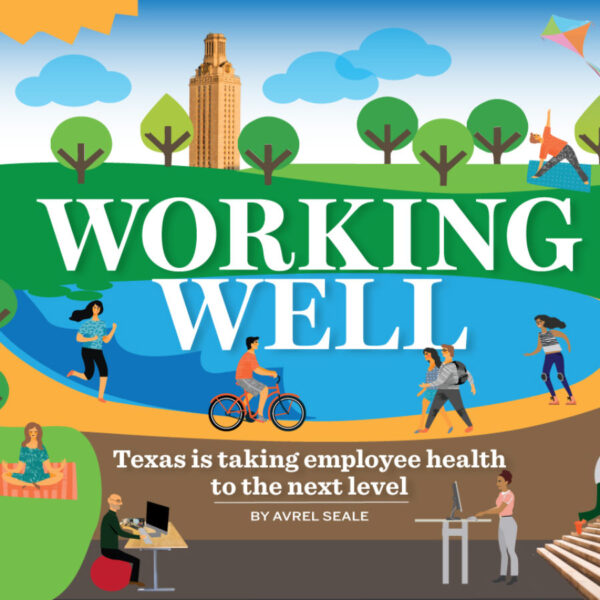It wasn’t always this way.
When Charles Dickens imagined an employer making the ultimate show of care for an employee, he had Ebenezer Scrooge give Bob Cratchit a turkey.
Until World War II, work was work, health was health, and rarely were the two ideas combined. But when 16 million Americans were pulled into the military and millions more into the home-front war effort, employers were desperate to attract workers. They couldn’t attract them with higher pay because the federal government had instituted wage controls during the war. So, the only carrot employers had left was the relatively new concept of benefits, things of value that were not counted as wages. The biggest of those benefits was health insurance.
Once employers began underwriting health insurance, they soon realized that keeping employees out of doctors’ offices by encouraging healthy habits was simply good business. Conventional wisdom and common sense now tell us that healthier employees make better employees. Not only do they miss less work, they do better work. But at many workplaces, this enlightened self-interest is being overtaken by an even more revolutionary concept: It’s the right thing to do.
Adrienne Howarth-Moore is UT’s point person for employee health. “Healthy and engaged employees have higher morale, are more productive, and are better equipped to thrive in their career and support the students they serve,” says the director of UT HR’s program known as HealthPoint: Balance & Well-being in Work & Life.
“With the majority of an employee’s waking hours spent in the workplace, one of the best places to encourage health and well-being is right here at UT,” she says. “We want to make the healthy choice the easy choice while you’re on the Forty Acres.”
For many decades, The University of Texas at Austin has supported the health of its employees, with programs for weight loss, nutrition programs, smoking cessation programs, elder care support groups, free flu shots and lactation rooms. But in 2013, this already robust slate of initiatives became even more sweeping because they gained a powerful new in-house ally: UT opened a medical school.
The mission of a medical school, of course, is to educate future doctors. But Dell Medical School is also deeply beholden to Austin and Travis County voters, who in 2012 elected to raise taxes to help fund the school with an annual investment. In addition to educating future doctors, Dell Med is focused on improving health in Austin, not just for people challenged in their access to care but for everyone in Austin, including UT colleagues and their families. It could be a matter of “Think globally, act locally.” Or it could be a manifestation of “What starts here changes the world.” But in any case, UT is as serious about supporting employee health as it can be.
With 26,000 employees (includes student employees), UT is the largest employer in Austin, providing health coverage for tens of thousands of employees and their dependents. “By creating a culture of health here at UT, we positively impact the overall health of our Central Texas community,” says Howarth-Moore. For the many ways UT is creating this culture of health, it has won the Mayor’s Healthiest Workplace Award.
“The truth is, people don’t want more health care — they want more health,” says Clay Johnston, dean of Dell Medical School. “At Dell Med, the shift in focus from health care to health is front and center in our mission to revolutionize the way people get, and stay, healthy.
“We are focused on measurably improving health locally as a model for the nation — in the simplest terms, we want Austin to be a model healthy city. As part of that effort, we are also thinking about our own internal culture of health and how we can support our faculty, staff, residents and students.”
Under the banner of “Health Is Happening Here,” Dell Med is inviting a wide range of local partners — including the greater UT community — to collaborate in building and supporting what Johnston and his team refer to as the “health ecosystem.”
Johnston says that healthy living is central to the medical school’s work. “And to be successful, we need to engage and work with partners across our community. So, when we talk about how ‘health is happening here,’ we are referring not just to the school’s focus on health, but also to the progress that’s being made with all kinds of essential collaborators, from entrepreneurs and housing advocates to health care providers and local health advocates.”
Move It, Move It
Poet Ogden Nash once observed, “People who work sitting down get paid more than people who work standing up.” He was no doubt right. But there is now widespread recognition that whatever extra money the seated class does make all too often goes straight to doctors and pharmaceutical companies; sitting for extended periods is simply ruinous to health.
At UT, more than 8,000 staff members work in executive, professional and clerical positions, i.e. desk jobs. That’s a lot of sitting. Improper posture or desk arrangement often lead to discomfort if not chronic pain. And the costliest category for medical claims for UT staff? Musculoskeletal and connective tissue issues, often the fruits of bad posture and inactivity.
There are two related but distinct solutions: not sitting as much, and frequently moving. To have what is essentially a desk job but not sit all day requires a deliberate effort to get up and move. You can set a reminder for yourself to move and stretch for two or three minutes every hour. For ideas about stretch-at-your desk activities, visit sites.utexas.edu/ergonomics/exercises. There also has been an increase in the popularity of standing desks.
Based on medical claims for UT, some of the top modifiable health risks are for diabetes, hypertension, high cholesterol, and poor back health. All of these can be improved by increasing regular physical activity. There are myriad benefits of increased activity, including weight control, cancer risk reduction, strengthening bones and muscles, and improved mood and overall mental health.
Take a walk at lunch or try a new physical activity that brings you joy. “For me,” says Howarth-Moore, “bowling at the Union is great fun and a good way to get moving rain or shine.”
Howarth-Moore says the campus operates many partially hidden gems, such as the HealthPoint Stress Reduction & Biofeedback Room, the Get FIT Program, and RecSports Mobile Massage Services. But her personal favorite — when the weather is cool — is to walk the UT Landmarks map. “There is something very rejuvenating for the mind and body when you walk outdoors and take the time to pause and reflect on the amazing pieces of public art displayed throughout our campus.” You can create a self-guided walk route or join a docent-led public tour by going to landmarks.utexas.edu/collection.
One easy win for moving more is your office’s nearest stairwell. Taking the stairs multiple times a day might give you all the workout you really need. An initiative is underway to increase stair use by making stairwells more visually interesting with graphics, inspirational quotes, photos and other artwork.
Gregory Gym, a campus institution with hundreds of faculty and staff devotees, is a great option for getting in a workoutif you work nearby. But the “Forty Acres” is actually 424, and UT wants to remove as many barriers to activity as possible.
In November, UT opened the Points of Health Model Healthy Gym in the University Administration Building. This new initiative seeks to create “Points of Health” mini-gyms that are unstaffed and tucked away in buildings farther from the center of campus. These might have blood-pressure machines along with gym equipment that doesn’t require supervision.
If travel time is one barrier to getting physical activity during the day, another is sweat. One way to avoid the need for a midday shower is a yoga class.
Often departments are in the best position to know what would make their environment healthier. So UT, in partnership with the UT System LivingWell Program, created wellness mini-grants that departments use to purchase a piece of gym equipment, a shared standing workstation, arrange for a department yoga class, or create a local stress-reduction and biofeedback center. UT also provides biometric health screenings so employees can easily check their blood pressure, cholesterol, triglycerides and blood sugar levels. The health screenings come to campus twice per year.
Know Your Safety Hub
Whereas some health problems take decades to show themselves, other often life-threatening ones can manifest in seconds. So, another item on all employees’ lists should be to get acquainted with their building’s “safety hub.” Each safety hub consists of the following components:
- An automatic external defibrillator (to shock the heart back into a normal heart rhythm)
- An emergency call box. This notifies campus police of where an emergency is.
- A bleeding control kit, and
- Signage showing the building name and abbreviation, in case you have dialed 911 instead of using the emergency call box.
Safety hubs are found at the “celebrated entrance” of each building, which is generally the door that gets the most foot traffic. Getting to know your closest safety hub can mean the difference between life and death for your co-workers and visitors. preparedness.utexas.edu/safety-hubs-campus
Where There’s Smoke, There Are Big Problems
We’ve come a long way from the days when a haze of cigarette smoke polluted virtually every indoor space in the world. But tobacco use is still the No. 1 preventable cause of death and disability. One in 10 Travis County residents are smokers, and a startling 39 percent of Austinites between ages 18 and 29 are using the carcinogen, 54 years after the surgeon general declared it a terrible idea. Heart attack; stroke; emphysema; chronic bronchitis; gum disease; cancer all over the body but especially in the lungs, tongue and mouth; even diabetes. The list goes on.
Of course, it is one unhealthy habit that does not respect the boundaries of personal space. UT became a tobacco-free campus in 2013, helping protect staffers and visitors from second-hand smoke and helping tobacco users quit or at least cut back.
UT is committed to helping staff and faculty members quit tobacco by offering free programs and therapies, including pharmaceutical and nicotine-replacement therapy. UT would like to increase cessation attempts by providing on-site tobacco cessation classes.
“If you’re a non-smoker already, then give yourself a gold star,” says Howarth-Moore. If not, check out our free or low-cost cessation resources.
Life in the Balance
Today, about 1 in 10 of us are addicted to tobacco, but the percentage of us addicted to smartphones is close to 100. It is our telephone, our email, our TV, our newspaper and often our primary source of information about everyone we know.
Whatever else this addiction might affect, we know it affects sleep. Avoid your smartphone, tablet and TV an hour before bed to establish good sleep habits. Getting enough sleep is not a luxury; it’s a medical necessity.
Don’t overschedule your week; downtime such as daydreaming, meditation or reading a good book can spur your creativity and problem solving. Plus, it can improve your mental and physical health.
Lastly, don’t be a bully to yourself. Associate Professor Kristin Neff is a leading researcher and has written several books on the idea of self-compassion. When we motivate ourselves from a place of kindness rather than criticism, we can substantially improve our overall health and well-being. “The more self-compassionate versus self-critical that people were, the lower their cortisol levels and the higher their heart rate variability,” she writes in “Self Compassion.” If you are curious about how much self-compassion or lack thereof might be affecting you, try taking Neff’s test at self-compassion.org.



